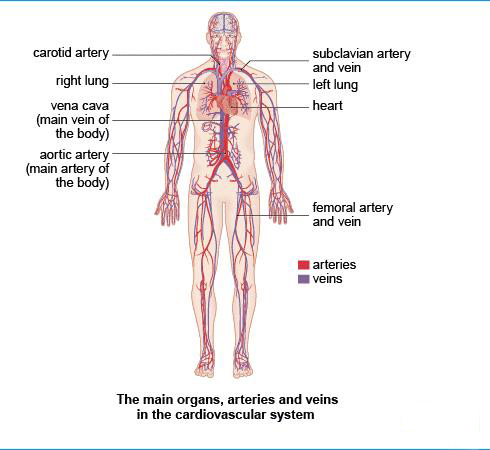The cardiovascular system supports every other function in our bodies. From the way we move to the fact that our brain gets enough oxygen, we have the cardiovascular system to thank. The cardiovascular system includes the heart and all the vessels and arteries that branch out from it, delivering blood and oxygen to every inch of our bodies.

How does it work? The heart pumps about 10 pints of blood through the body with very beat. That blood travels through a complex system of arteries, veins and capillaries. The blood carries oxygen and nutrients to every cell of the body. The cardiovascular system is actually comprised of two systems: The pulmonary circulation, in which the heart pumps the blood to your lungs and back again, and the circulatory system, in which the heart pumps the oxygen-rich blood to the rest of the body.
Major Functions of the Cardiovascular System
The cardiovascular system is crucial in many other ways, not just in moving oxygen and blood around. The function of the cardiovascular system include keeping our bodies at a constant temperature, maintaining fluid balance throughout the tissues, protecting the body from blood loss and infection, and helping move waste products out of the body. Here is more detail about what the cardiovascular system does:
1. Transportation
Picture a major highway. Now, picture the small roads that branch off that major highway, the ones that lead to small town. Now picture even more roads, those that lead to small neighborhoods. Then add in more roads - the driveways that lead to houses. This system of transportation is the same kind of system that makes up the cardiovascular system. All those "roads" are veins, arteries and capillaries that carry the blood from the major artery all the way out to the small capillaries.
The heart works with the lungs to take oxygen to the farthest reaches of your body and exhale the carbon dioxide that has built up in the cells. The blood also carries nutrients, hormones, waste products and sometimes medications through the body. This is all a seamless transportation system that happens without any thought at all on your part. Your body works like a well-oiled machine through the functions of the cardiovascular system.
2. Protection
Blood cells are made up of three parts, and each part has a job to do when it comes to protecting your body from infection or illness. Here's how it all breaks down:
- Red blood cells. The red blood cells are what carry oxygen through the body. They travel to the lungs, where the lungs provide oxygen with every breath. That oxygen then binds with hemoglobin, a special protein in the red blood cells. The cells then travel throughout the body, dropping the oxygen where it is needed and picking up the carbon dioxide to be released into the lungs.
- White blood cells. White blood cells are the warriors of the body. Their job is to find infection or foreign bodies, then wrap around them and attack, killing the invader. Once that is done, they also create antibodies, which can help your immune system fight off the infection if it happens again.
- Platelets. When you get cut or injured, platelets do the job of closing up the wound. They connect to proteins released at the site of the cut, thus creating a thick barrier that blocks the loss of blood. If you don't have enough platelets in your blood, the ability to heal is diminished. If you have too many, the buildup in the body can lead to problems, like strokes or heart attacks. To avoid this, sometimes doctors prescribe blood thinning medications.
3. Thermoregulation
In order to stay healthy and work at the optimum level, your body must keep a nearly constant temperature. Though the optimum temperature can vary from one person to another, for most it lies between 97 and 99 degrees Fahrenheit. The cardiovascular system helps regulate the temperature with the following:
- Sweat glands. Thermoreceptors in the body go on alert when the temperature rises. The response is sweat secreted onto the surface of the skin in an attempt to cool things down.
- Muscle around arterioles. At the same time, the muscles around the vessels relax, allowing more blood to pump through. This brings a rush of blood to the skin, allowing the body to cool off. The cardiovascular system diverts just enough blood from the organs to the skin to make this happen. But if the temperature of the body drops, the muscles around the arterioles will constrict, thus forcing blood back to the organs and thus maintaining a core body temperature.
- Skeletal muscle. Have you ever begun shivering when you were really cold? That's the body doing its job to warm you up. The body will trigger very small, constant muscle contractions. These muscle contractions produce heat, which can then help raise your body temperature.
- Endocrine gland. When the temperature of the blood drops, the body goes into overdrive with hormone production, creating plenty of thyroxin, adrenaline and noradrenaline. These hormones trigger an increase in the metabolic rate, which then warms the body.
4. Fluid Balance
Balancing the fluids in the body means that every cell gets the proper amount of electrolytes, nutrients and gases. When you are dehydrated or when you have far too much fluid in your body, your cardiovascular system knows by the changes in blood volume. To compensate, your body then triggers hormones that target certain functions, such as increasing urine output or kidney function. Your blood vessels might also constrict or expand, thus allowing more or less of the body's fluids to be lost through sweat.
The functions of the cardiovascular system happen involuntarily, creating a complex web of actions that help keep your body as healthy as it can be.